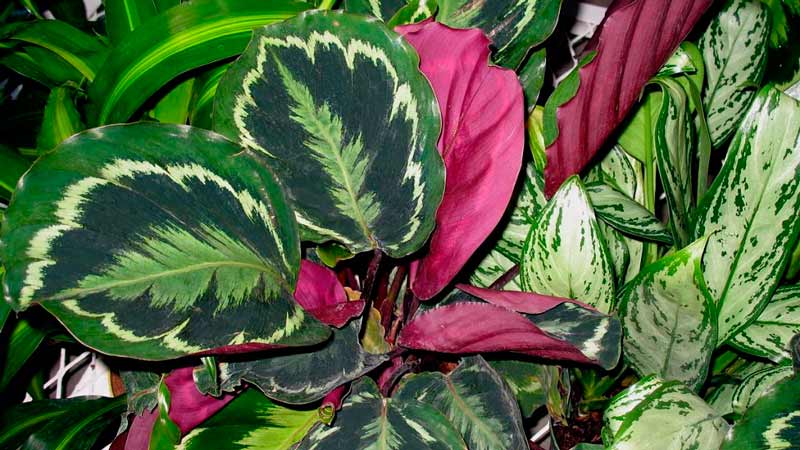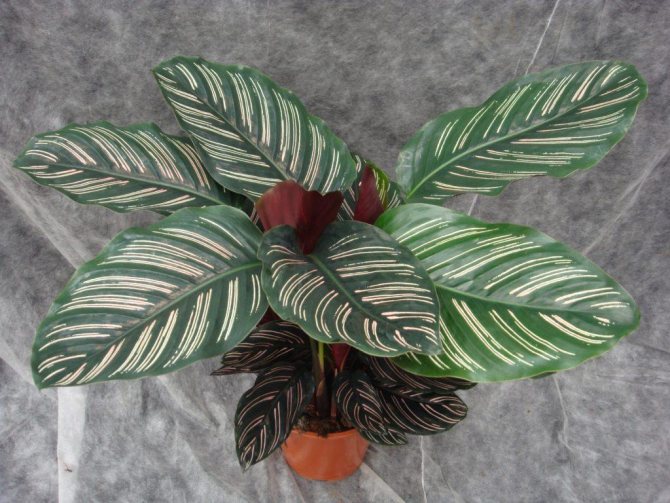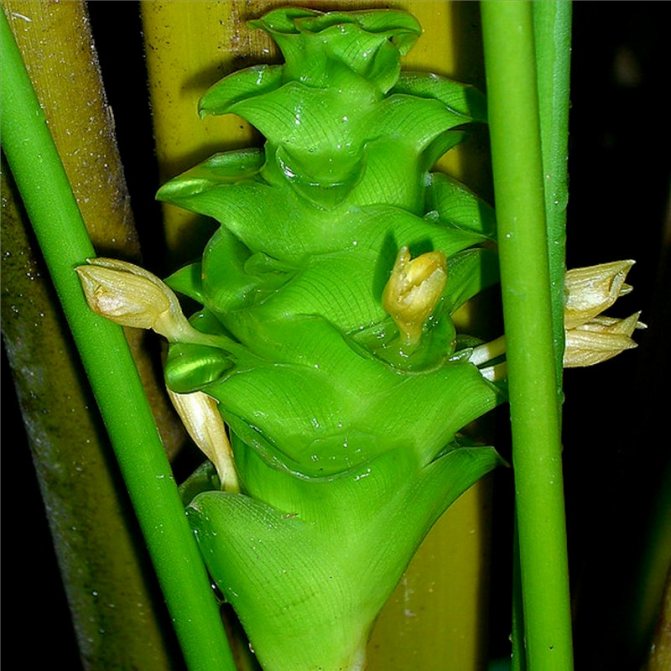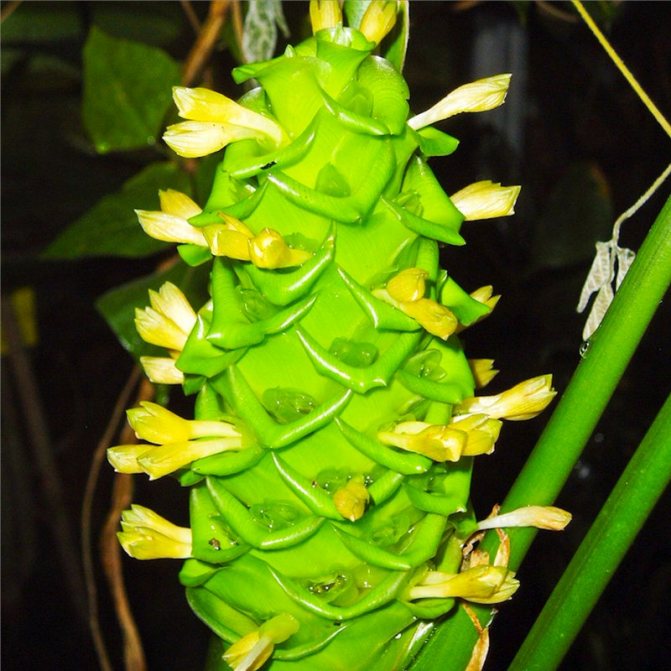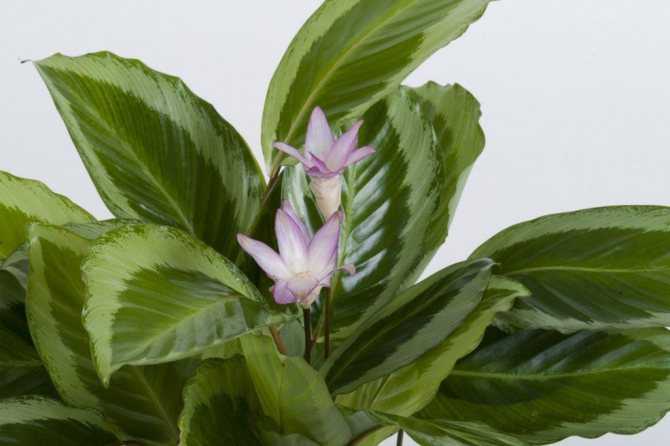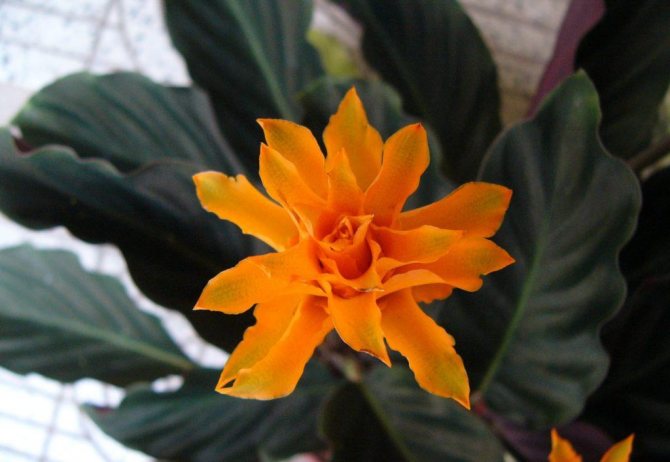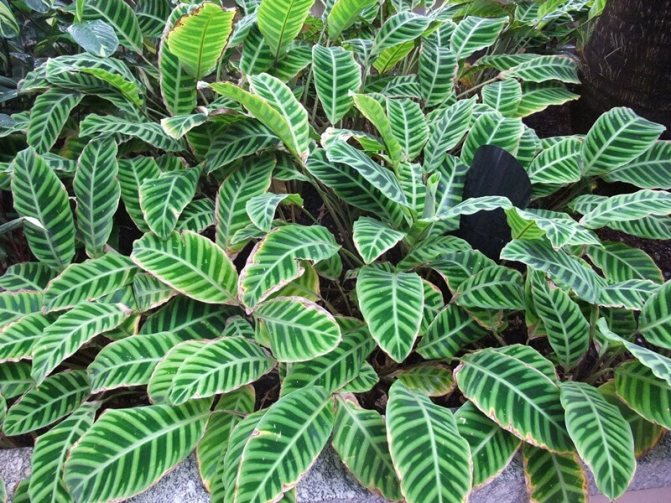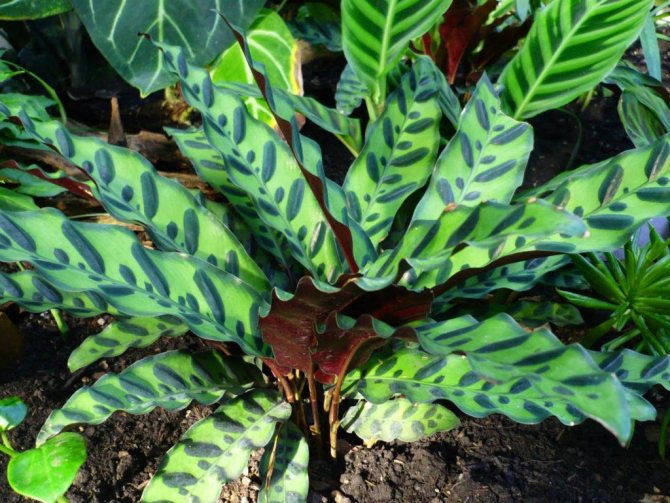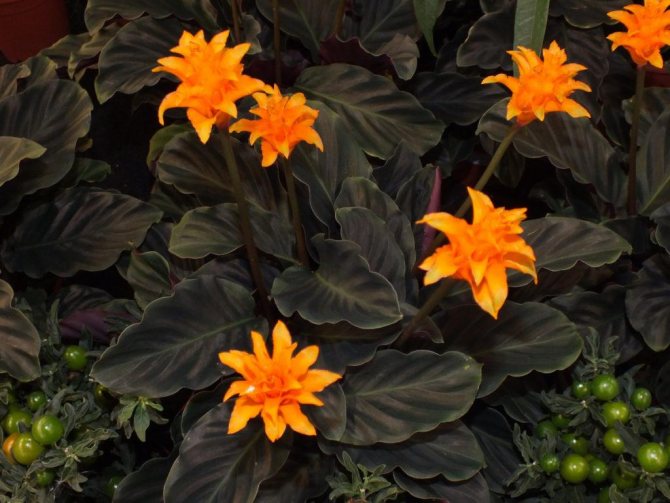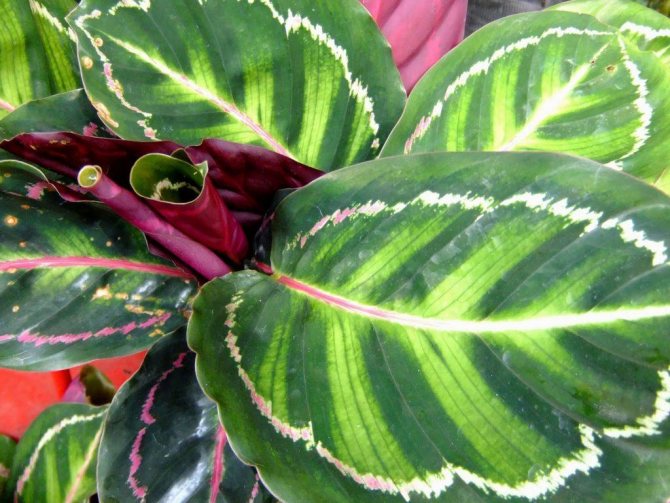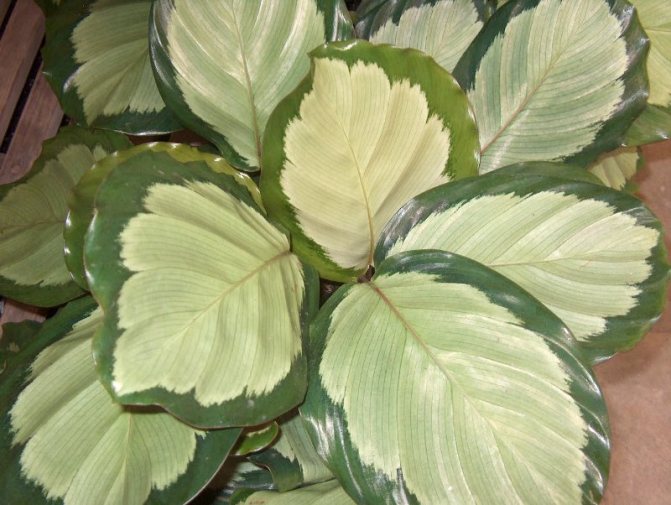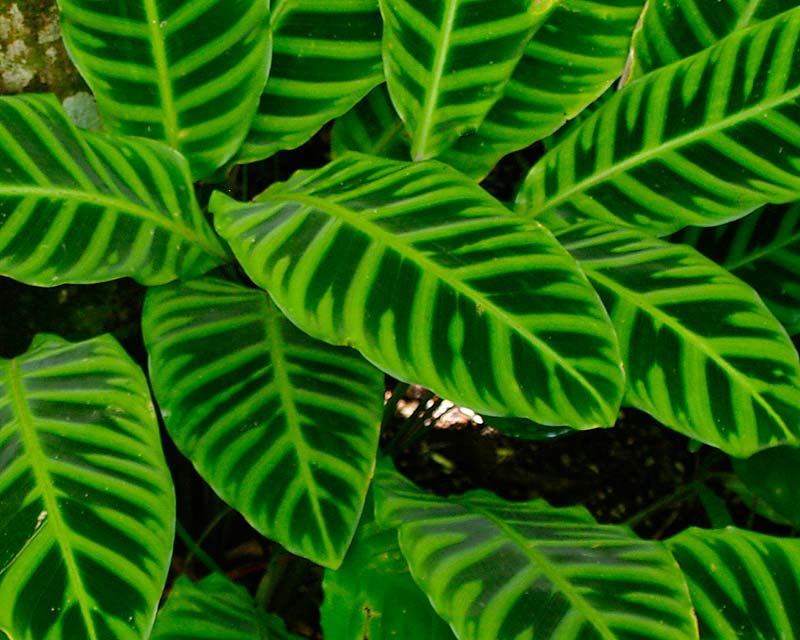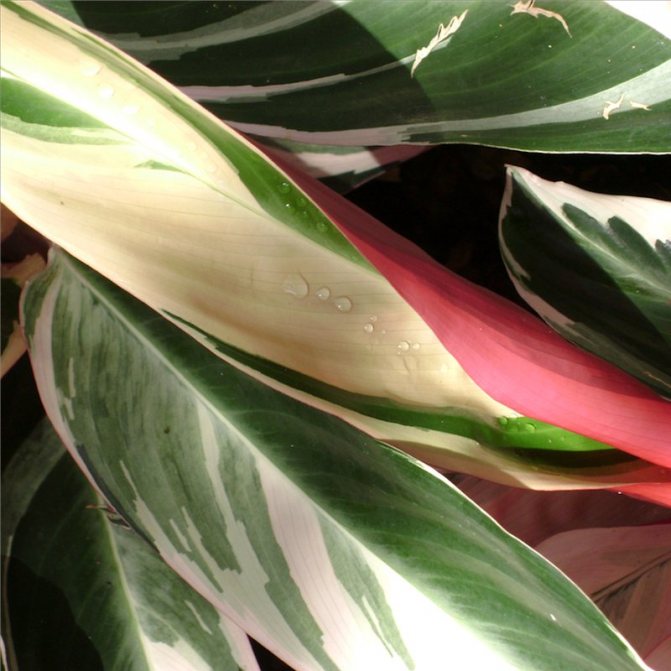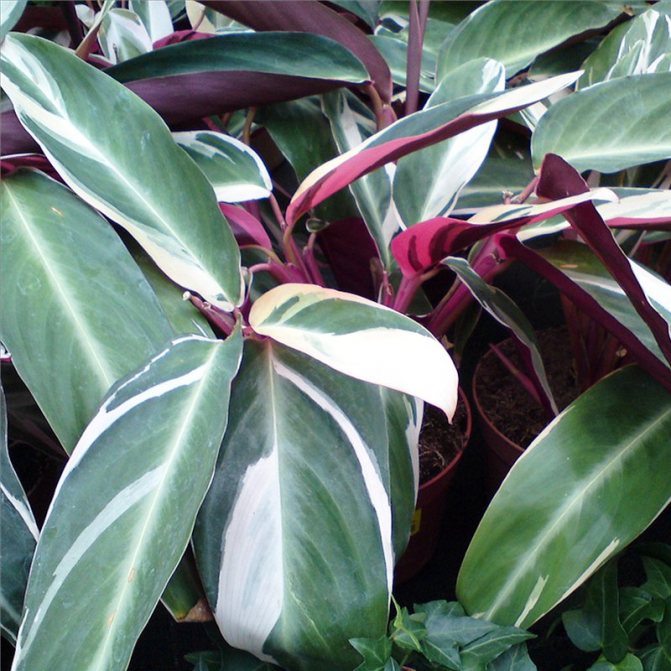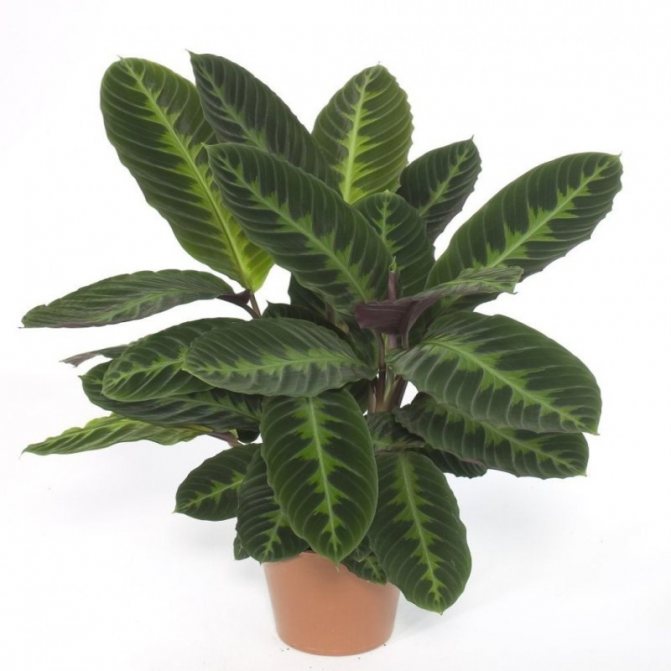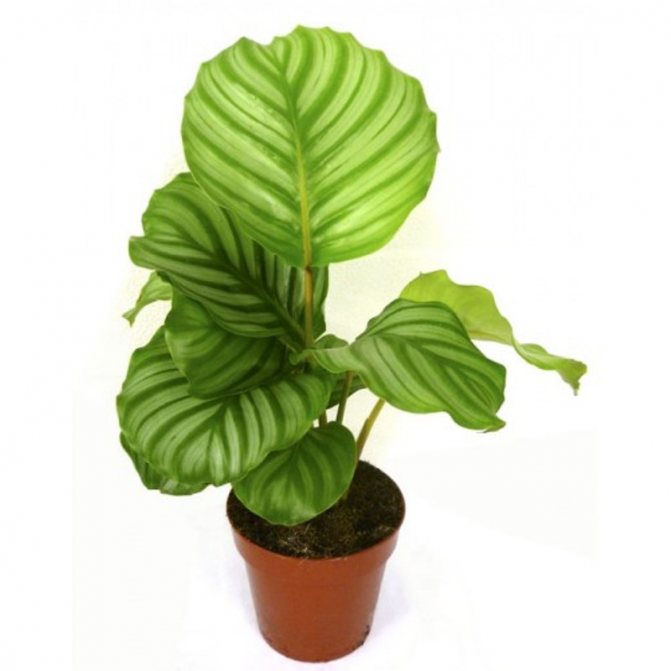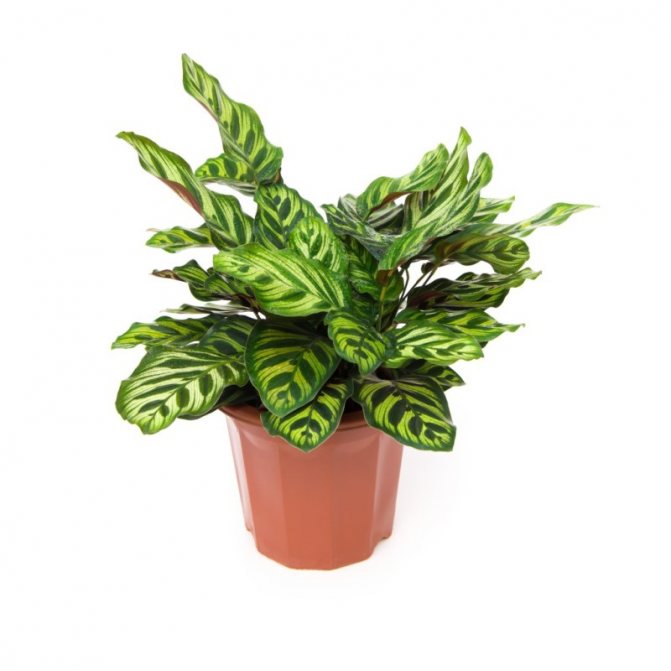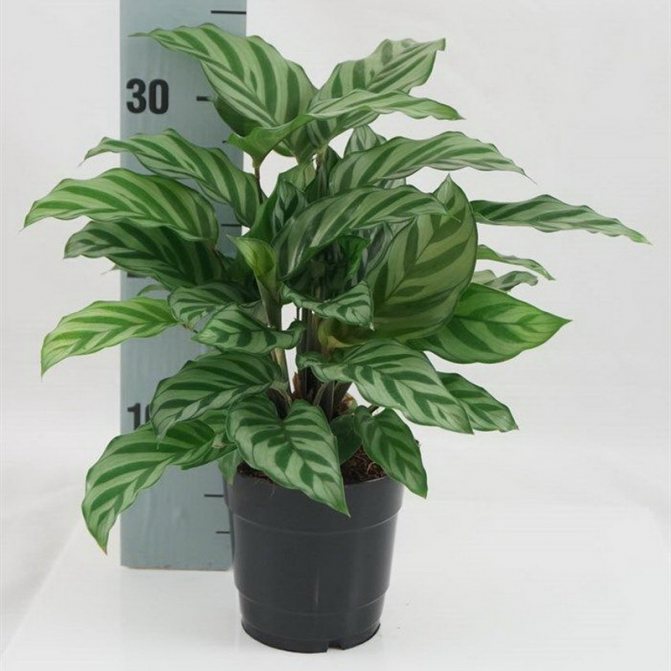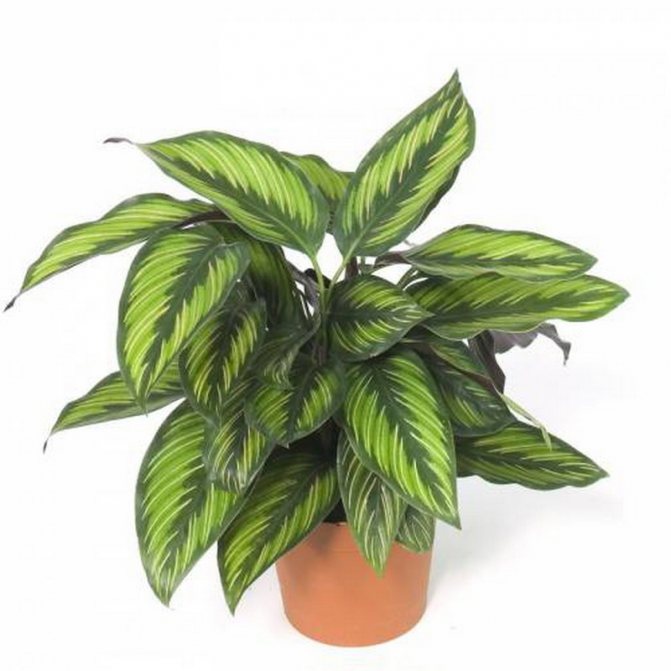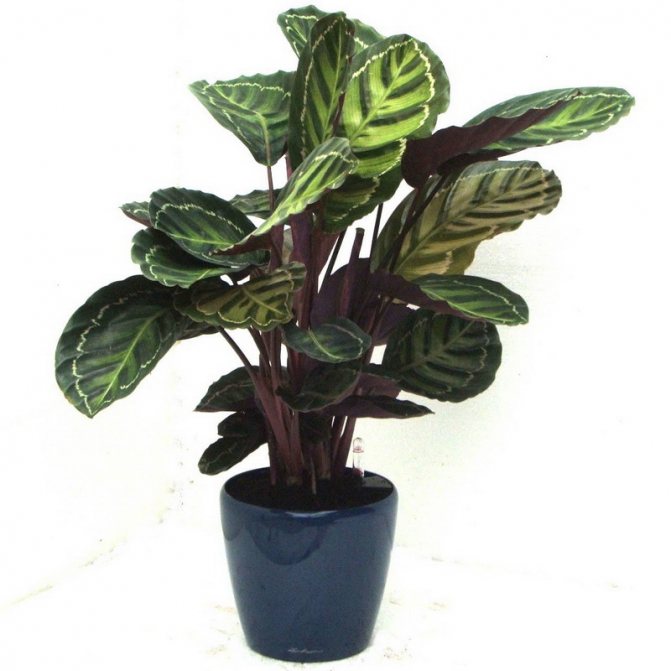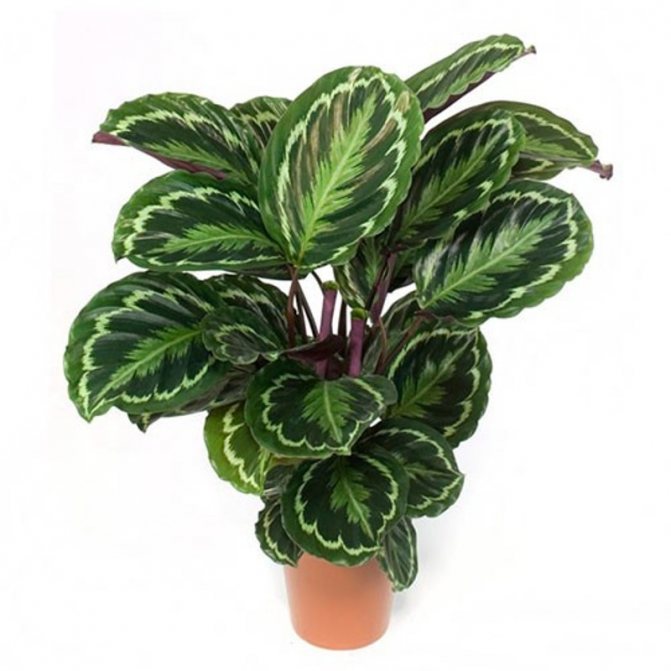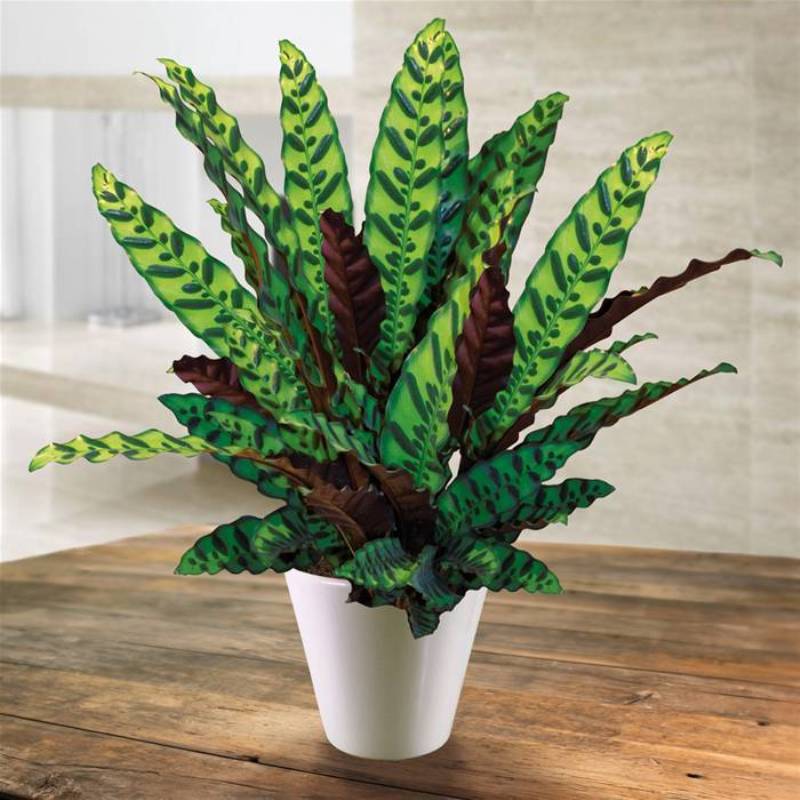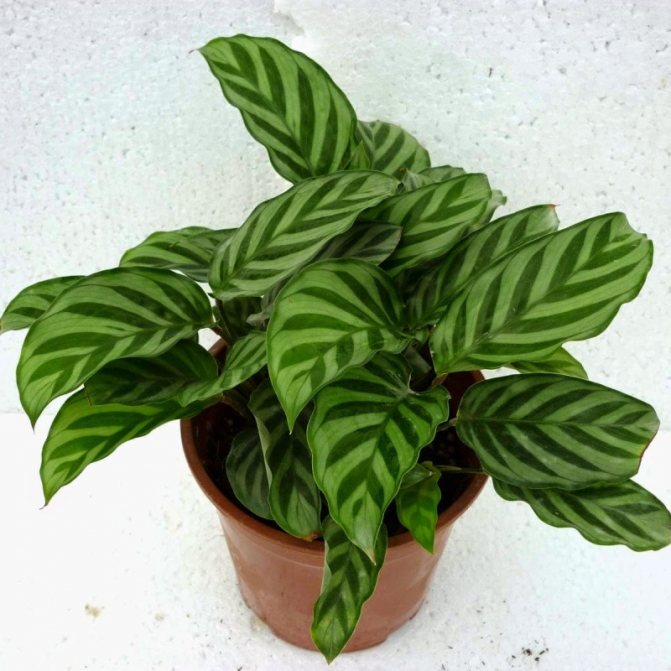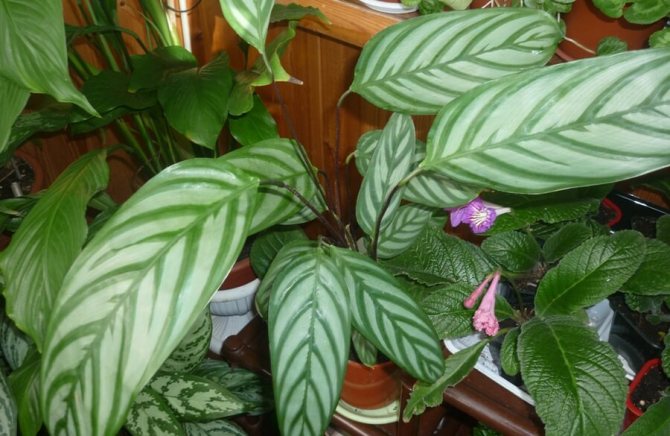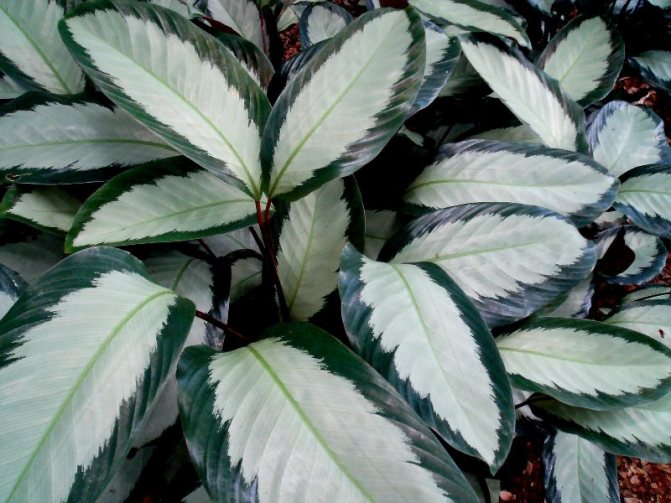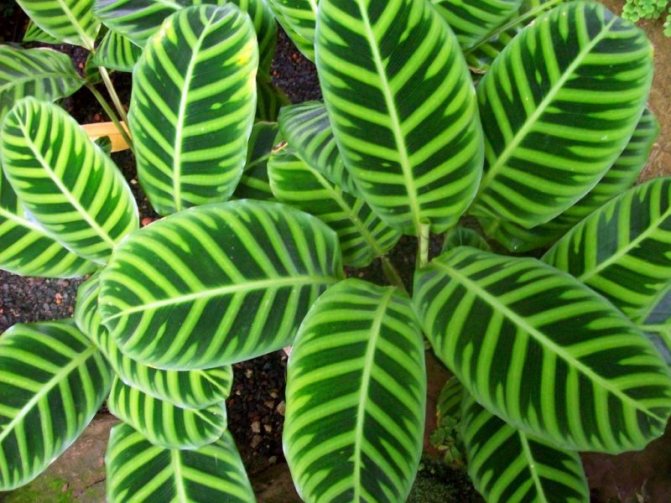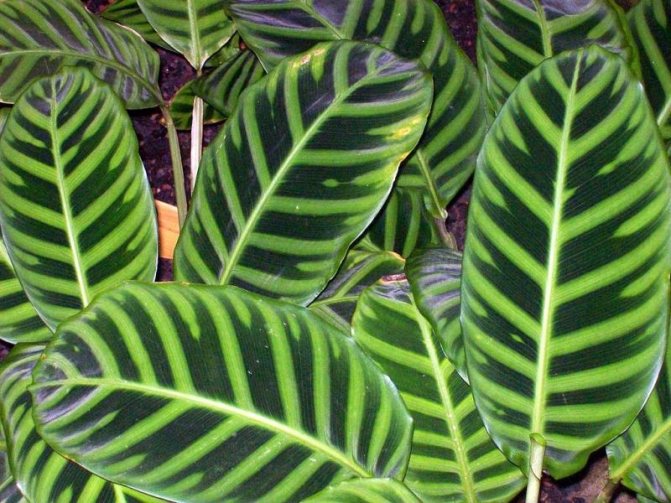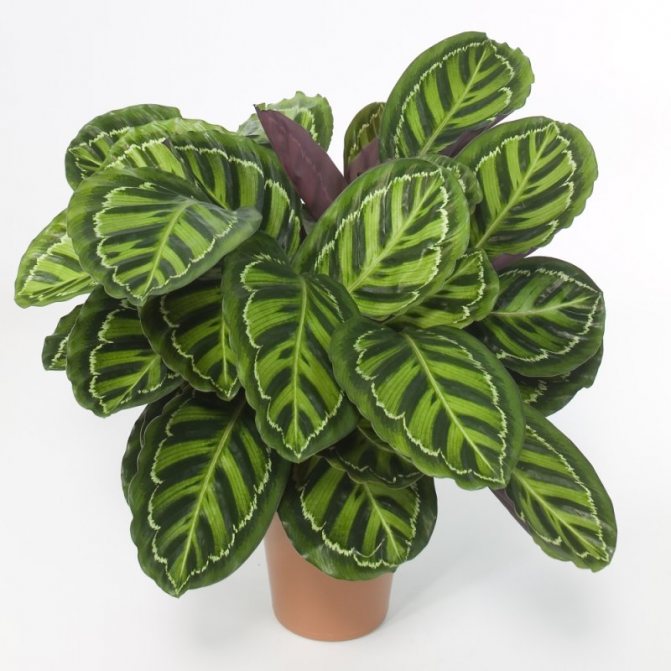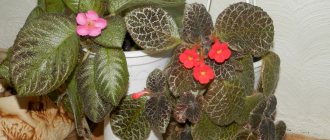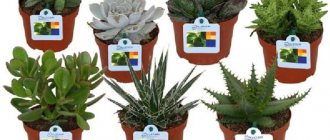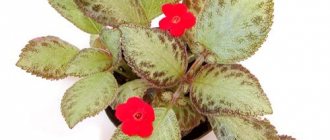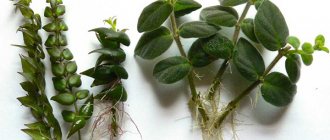Calathea is a well-known houseplant from the arrowroot family. It is grown for very decorative leaves with outlandish patterns. The different species come in an amazing variety of colors.
Calathea is a very demanding plant... His homeland is the tropics of Central and South America. In the wild, it can be found in forests on the banks of water bodies. At home, it requires careful care, since it is not easy to create suitable conditions for it.
In the heading you will see photos and names of species of room calathea.
Loading ...
Photo gallery
In the warm season, calathea feels comfortable at an air temperature of + 20–25 ° C, in winter it is not lower than + 16–18 ° C. In conditions of high humidity, the maximum allowable is + 30–35 ° C. The lower limit that a flower can survive is + 16 ° C, then root decay will begin.
The daylight hours of this plant should last 10-14 hours, so in the cold season you need to use additional lighting. With a lack of lighting, the flower stops growing and sheds its leaves.
Kalatei needs high humidity - at least 60%, and preferably 90–95%. Therefore, the air near the flower should be sprayed frequently, especially in winter. You can also increase the humidity level by placing a container of water next to the flower.
During the flowering period, you need to feed the calathea with fertilizer for flowering plants, for example "Agricola", every 14 days. After that, the wilted flowers should be cut off, leaving 5 cm and removed completely when they dry out.
Lighting
In nature, calathea grows under the crowns of large trees that protect it from the sun. Direct sunlight is harmful to the plant and leaves burns on the leaves.
Optimal lighting for calathea is diffused light or light partial shade.
The most difficult thing is to find a place for the calathea with suitable lighting. Lack of light causes the leaves to turn pale, they lose color. Too intense light, even diffused light, causes yellowing of the leaf blades.
The most suitable place for calathea is windows facing west, east or southeast. If the plant stands where the direct rays of the sun fall, it will definitely need shading at noon hours (from 11.00 to 15.00).
The duration of daylight hours for this flower should be 14-16 hours... This can be achieved using artificial lighting. Calathea grows well under fluorescent or phytolamps. It is especially important to use them in the autumn-winter period, when the daylight hours are very short.
Loading ...
Where can you buy a plant?
You can buy calathea in flower offline and online stores. The cost ranges from 200 to 3 thousand rubles, depending on the type and size of the plant.
What to do right after buying a flower?
It is necessary to accustom the plant to new conditions gradually, for this you need to put it in a bright, but shaded place for 2 weeks, where it is warm, there are no drafts and dampness.
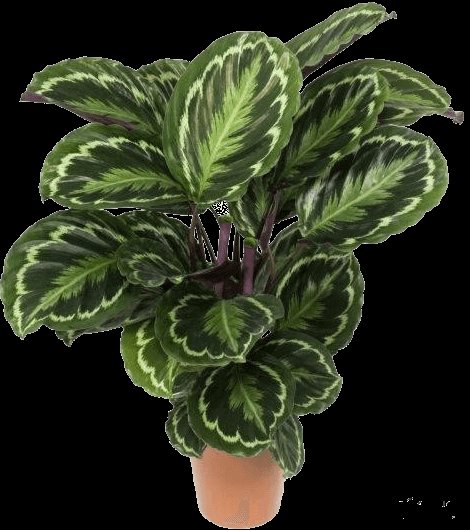
After adaptation, the calathea must be transplanted, completely replacing the soil and flowerpot, treated with "Zircon" using a spray bottle and watered abundantly.
Flower varieties
Each of the many varieties of kalata attracts attention with a "decoration" of symmetrical contrasting spots or stripes.
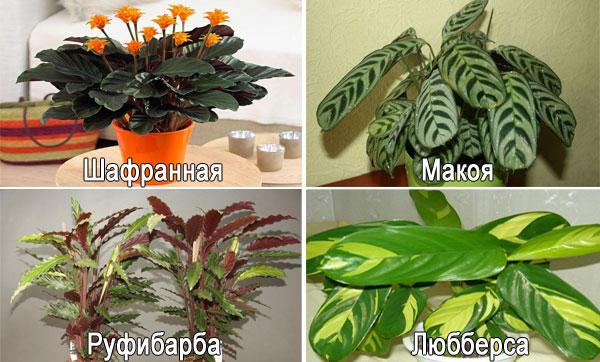

- Calathea saffron (crocata) is one of the few flowering species. The bush is compact; leaves are plain, inconspicuous. The flowers, collected in inflorescences, sit on straight, tall peduncles surrounded by bright fiery red bracts. This species is difficult to care for and is of little use for growing indoors.
- Calathea wonderful (lanceolate) has one full leaf in the outlet. The upper side of the leaf blade is light green, decorated with darker spots of regular oval shape; the underside is purple.
- Kalathea Makoya is distinguished by large, up to 30 cm, leaves, silvery-green with dark green edges and the same spots of different sizes that diverge from the central vein.
- Calathea orbifolia is one of the most beautiful representatives of the genus. Its large, wide leaves are lined with clear symmetrical stripes of dark green and light green colors. Petioles are high, up to 40 cm.
- Decorated calathea (sanderiana) is a common and unpretentious type. A compact plant with yellowish-green leaves, "painted" with pink and silvery thin stripes. Sometimes it blooms.
- Kalateya Varshevich is distinguished by large, up to 1 m, elongated-oval leaves with a wavy edge. The surface is dark green, decorated with a lighter pattern. Another flowering variety. Forms spike-shaped inflorescences of cream or pinkish flowers with large cream bracts on short burgundy peduncles.
- Mosaic calathea (network) is attractive with light green leaves, densely lined with darker veins into small rectangles.
- Calathea Lubbersa is distinguished by an asymmetrical pattern of yellow and green spots.
- Calathea rufibarba has elongated leaves with a wavy edge. Their color, depending on the variety, varies from light to dark green.
- Leaves of Calathea Litze are medium-sized, up to 15 cm in length, elliptical in color, light green with a silvery sheen. Decorated with symmetrical wide dark green stripes. Blooms occasionally.
- Calathea Zebrina (striped) is another small-leaved variety with wide light stripes on a dark green background. The calathea mix, on the contrary, has a dark pattern on a light background.
- Calathea lancifolia is a widespread species with oblong, wavy leaves along the edge; there are wide symmetrical dark spots on a light green background.
- Calathea Bahema is an unpretentious species, often found on windowsills, with oval silvery-green leaves; darker stripes radiate from the central vein.
- Calathea medallion is also popular. Its wide oval leaves attract the eye with their original color: the central vein is bordered with light green strokes, and a light stripe runs along the edge of the leaf plate.
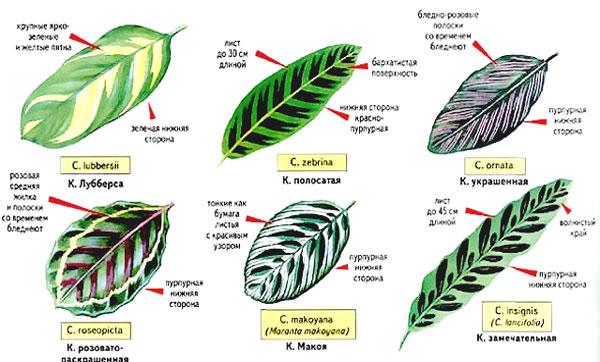

What kind of pot do you need?
Calathea has a superficial root system that grows in breadth, so a flowerpot needs a low and wide, shaped like a bowl. Each new container should be 4–5 cm larger in diameter than the previous one.
The most suitable material is unglazed ceramics, which provides the necessary volume of oxygen to the roots.
There should be drainage holes in the pot, and during transplantation, it is necessary to lay out a large layer of drainage on the bottom, which can be large pebbles, ceramic shards or expanded clay.
Photo
In the gallery, you will see calathea in the home and natural care process.
What kind of soil is needed?
Soil for calathea should be moisture permeable, nutritious, have good aeration and weak (pH 5.0-6.0) or neutral (pH 6.0-7.0) acidity.
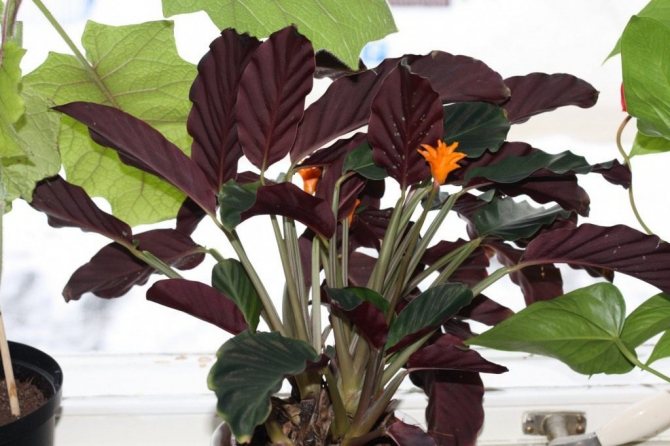

You can use ready-made soil for arrowroot or azaleas, or prepare it yourself by mixing in equal parts:
- high-moor peat;
- leafy ground;
- humus;
- coarse sand.
To deoxidize the resulting substrate, you need to add crushed charcoal to it at the rate of 40 grams per 1 kg of soil mixture.
The soil should not contain lime.
To get rid of pests, the soil mixture must be steamed in a water bath, spilled with a weak solution of manganese, baked in the oven or treated with insecticides and fungicides, for example, "Aktara", "Aktellik" or "Fundazol".
Transfer
Due to the specific toxins released into the soil by the roots of the plant and leading to its death, transplantation is a necessary procedure for calathea. It is better to spend it in early spring.
Reasons for transplant:
- disease;
- overgrowth of the root system;
- 14 days have passed since the purchase.
Before calathea reaches 3 years, it needs to be replanted annually, then every 2-3 years.
Transplant instructions:
- water the plant abundantly 1.5 hours before transplanting;
- lay out a drainage layer a quarter of the height of the container on the bottom of the flowerpot, sprinkle it with crushed charcoal or activated carbon to prevent root decay;
- pour a layer of soil on top not exceeding 2-3 cm;
- carefully remove the calathea from the old container along with a lump of earth;
- rinse the roots in cool water;
- cut off all damaged roots with a sharp knife strictly perpendicularly, remove old and dry leaves;
- treat the cut sites with crushed activated carbon or wood ash;
- place the plant in a new pot and soil, carefully spread the roots;
- make sure that the growth point is strictly in the center of the flowerpot and above the ground surface;
- carefully pour the soil into the pot, leaving 1.5–2 cm to its upper edge;
- lightly crush, but do not compact the soil.
After transplanting, it is necessary to water the calathea abundantly and remove for 2-3 days in a cool place where direct sunlight does not penetrate. The next watering is carried out after 8-10 days.
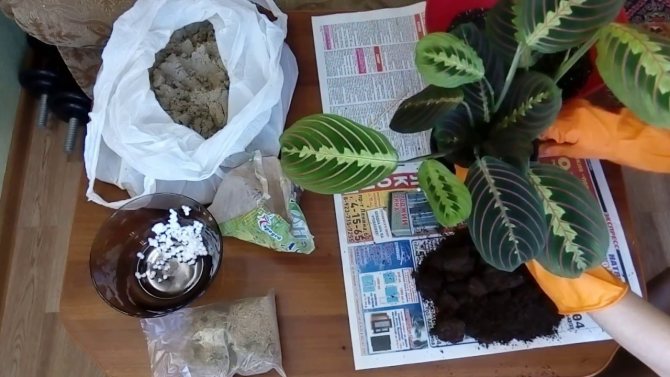

Reproduction of calathea
The plant reproduces in three ways:
1. The easiest way is to divide the bush. This can be done when transplanting it by dividing the plant into several parts. When each of them has a growing point and a good root system, then the bush will definitely take root. Sprinkle the damage that occurs when dividing the bush with charcoal.
2. Cutting does not always end with success, because, having a growth point, the rhizome still needs to grow. Place the cutting in a moist substrate and cover with a transparent cap, creating a greenhouse environment for it. Remove the ventilation hood daily. Just like cuttings, leaf propagation is performed.
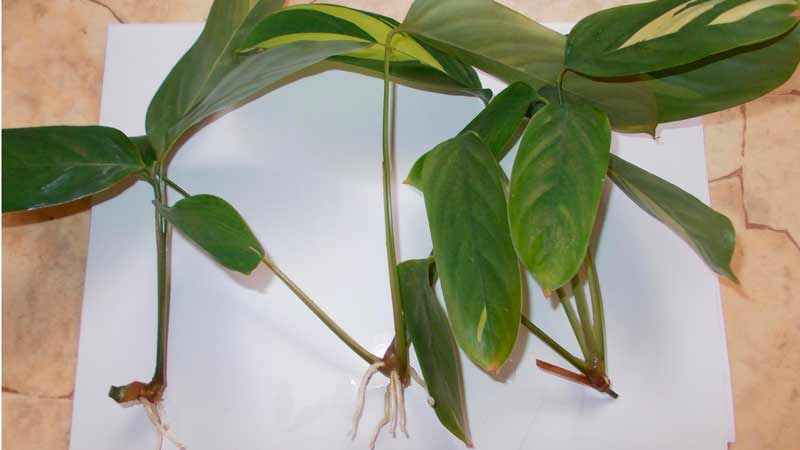

3. Seed propagation is the most difficult propagation method. Seeds usually do not germinate well and seedlings do not grow very well. Seeds must be disinfected in a 1% solution of potassium permanganate. Then sow them on the surface of the soil, cover with transparent film or glass and place in a semi-dark warm place.
Before emergence, regularly ventilate and moisten the soil. If you place the container in a florarium, where all the necessary parameters are observed, then for seedlings this will be the optimal solution.
When sprouts appear, they need to be cut into separate containers, and rooted plants in permanent pots.
Transplant, rejuvenation, cuttings of calathea. Video:
Fertilization and feeding
During the growing season (from early April to September), fertilizers need to be applied every 2 weeks, and in autumn and winter, if the condition of the plant is satisfactory, reduce the number of fertilizing to 1 time in 1.5-2 months or completely abandon them.
Suitable fertilizers for plants of the Maranth family or universal fertilizers for decorative leafy indoor flowers, for example, Bona Forte, Pokon, Agricola or Etisso.
Calathea reacts negatively to excess nitrogen and calcium, the content of these elements should be reduced.
You need to apply fertilizing 10-15 minutes after watering, you can not fertilize the plant on dry soil.
Watering
On average, watering calathea in the summer requires 2-3 times a week, and in the winter 1 time in 7-8 days, but it is better to focus on the state of the topsoil - it should dry out 2-4 cm.
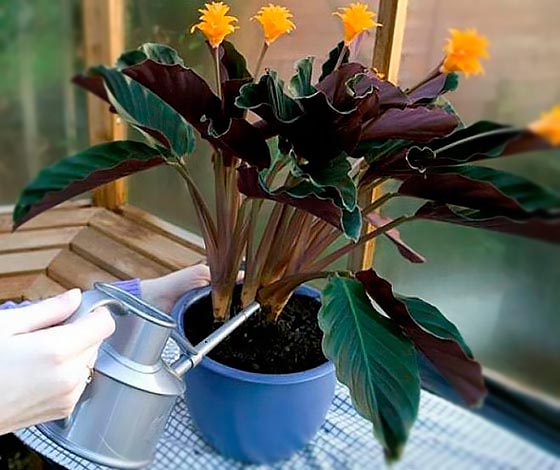

The water from the sump must be drained after 20-25 minutes. Stagnation of moisture should not be allowed, it leads to decay of the roots.
It is necessary to avoid getting water on the leaves of the calathea, therefore, for watering it is better to use a watering can with a narrow spout, and for spraying - a spray bottle that sprays small drops. If water gets on the leaves, dark spots appear on them.
Water for irrigation and spraying should be soft, ideally rain or thawed, and have a temperature not lower than + 25-26 ° C.
Calathea varieties with velvety leaves should not be sprayed.
If you are going on vacation
Calathea can be left unattended for no longer than 3-5 days, for a longer period it may die.
The plant cannot be watered in advance or not to control the watering process, this will lead to decay of the roots, and without moisture, the calathea will dry out.
Care features
After planting and choosing a suitable place for the Cattleya, further caring for it will not be difficult.
Watering
The Cattleya should only be watered after the potting medium is dry. Watering frequency will vary, as some factors will speed up the drying out of the land, others will slow it down. Watch each plant carefully, as soil can dry out at different rates in individual pots.
Water it liberally until excess water comes out of the drain holes. Improper watering, both inadequate and overwhelming, is recognized as the main cause of death for most orchids. Remember that plants recover much faster after underwatering, so it is best to follow the rule: "When in doubt, don't water."
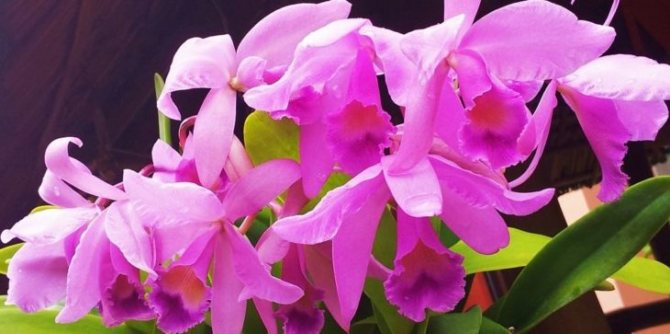

When watering, you need to be careful not to get the flower stalk wet. The leaves of the plant can be periodically wiped with a damp cloth.
Top dressing
Cattleya, like other orchids, can grow and even bloom for several years without fertilization, but the result will be better with an adequate nutritional regimen. Historically, orchids planted in bark have been formulated with a high nitrogen content (30-10-10), but current research indicates that high amounts of nitrogen can accelerate substrate degradation.
The best choice would be a low nitrogen, urea-free formulation such as 10-10-10 or 13-13-13. It is necessary to use fertilizers in the form of a solution every 2 weeks during the active growth of the peduncle and pseudobulb. After the beginning of flowering, fertilization should be stopped.
Overfeeding can lead to loss of roots and subsequent death of the plant, and in a well-rooted orchid, vegetative growth instead of flowers.
Transfer
Cattleya orchids are difficult to transplant, so this should be done only if necessary, that is, if there is no place for the roots, the plant begins to rot or the soil is oxidized. This usually happens after 1-3 years. It is best to transplant when roots begin to appear at the base of the processes or immediately after the growth of these same processes begins. For most Cattleya, transplanting time is not so important if using a substrate that is easily removed from the roots. However, there are exceptions. Many of the bifoliate varieties do not tolerate “moving” well if done before new roots are formed.
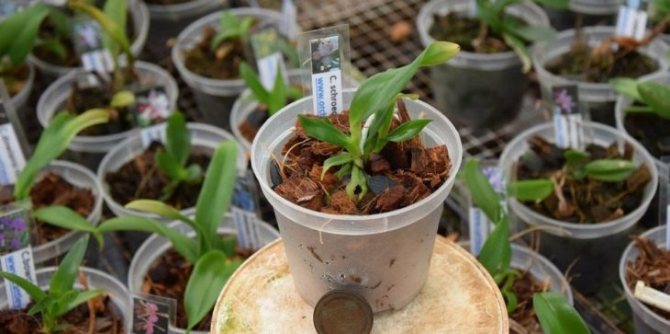

To transplant a bush, you need to carefully remove the roots and clean them of the substrate. To facilitate this task, it is recommended to place the rhizomes in warm water for a quarter of an hour. Examine the roots for dry and rotten areas, and if necessary, cut them off with sterilized tools.Air dry the orchid, then transplant into the prepared pot in the same way as for the first planting.
Reproduction of the cattleya orchid
You can propagate an adult flower by dividing the bush. This procedure is recommended to be carried out in the presence of at least 8 bulbs. Remove the bush from the pot, soak it in water and peel off the substrate. Divide the orchid into the desired number of parts, taking into account that each of them should have at least 3 bulbs, at least 1 bud and several roots. The incision should be made with a disinfected, sharp knife. It is desirable to cut the cut with charcoal. After that, you can start planting.
Other tips:
- Watch for any abnormalities, such as leaf spots, that indicate disease. An orchid can be affected by aphids, scale insects, spider mites, worms, whiteflies. You can get rid of these pests with insecticides.
- No pruning is required for this plant.
- Cattleya can grow tall; for this reason, keep a few bamboo sticks on hand in case the bush needs additional support.
- Don't be alarmed if you see roots twining around the base of the plant. This is normal; in their native environment, these roots help to hold onto trees or rocky cliffs.
Cattleya is not easy to care for, but its beautiful flowers are well worth the effort!
Pests. Table
| Name | How to find? | How to save? |
| Spider mite | A thin, barely noticeable white cobweb appears on the lower part of the leaves. The leaves begin to curl, turn yellow and dry. | wipe the leaves with warm soapy water, spray the plant with acaricides (Apolo, Borneo, Envidor), systemic (Biotlin, Calypso) or intestinal-contact insecticides (Fitoverm, Aktellik). |
| False shields | Pests feed on plant sap, secrete a lot of sticky excrement, which is why the leaves become sticky, begin to shine, and become covered with a bloom of gray or black. Young leaves dry up and old ones turn yellow. | • Wipe the calathea with cotton wool soaked in 70% alcohol or soap suds, repeat the procedure 4 times every 5–7 days; • spray with an insecticide such as Aktara, Aktellik or Intavir. |
| Mealybug | Cotton-like pellets appear on the stems, in the axils of the leaves, near the root collar, the growth of the plant slows down. | Wash the plant with soapy water, diluting 20 grams of soap in 1 liter of water. In case of severe infection, treatment with insecticides "Mosplan", "Decis" or "Fitoverm" is required. |
| Whitefly | A shiny sticky coating appears on the leaves; when you shake the plant, you can see how insects fly out of it. | Treat twice with an interval of 10 days with "Verticillin" or "Pegasus" or once with "Confidor", "Mospilan" or "Fufanon". |
Diseases
Consider how to care for calathea at home when the flower is sick.
Despite its exactingness, calathea is not very susceptible to various infectious and fungal diseases. Most often, the flower suffers from pests that willingly settle on it and multiply in large quantities.
The plant is attacked by red spider mites, scale insects and thrips.... These insects can quickly ruin its appearance, and sometimes even cause death.
If the leaves turn yellow and dry, and insects are found on them, it is necessary to treat the bush with an insecticide as soon as possible to completely destroy the pests.
If pests are detected on the plant, you can try to get rid of them using folk methods. For example, thoroughly wipe all parts of the plant with a cotton swab dipped in ethyl alcohol (70%).
Also, pests are afraid of laundry soap. Therefore, treating the flower with soapy water can help get rid of them. Such treatments are repeated every 2-3 days until the insects are completely destroyed.
If there are a lot of pests, it is necessary to use insecticides, for example, Actellika, Fitoverma, Inta-Vira.
Leaf problems. Table
| Symptoms | The reasons |
| The tips of the leaves dry and wither | Insufficiently humid indoor air. |
| Yellow or brown, but will not dry. | Excess feed or cold air, draft. |
| Leaves fall. | • low air humidity; • excessive watering; • acidic soil. |
| Leaves dry and curl. | If this is accompanied by a slowdown in growth, it means that the calathea does not have enough moisture or additional fertilizing. |
| Light spots on the leaves. | Sunburn caused by direct sunlight. |
| The leaves become long, thin and light colored. | Kalatea lacks light. |
Diseases
With proper home care, the flower is resistant to disease, but over-watering can lead to root rot. In this case, it is necessary to urgently transplant the plant with a complete replacement of the soil and flowerpot, removing all damaged parts of the flower.
Care errors
As a result of improper care, the calathea loses its decorative appearance, it is affected by diseases and pests, and the plant dies. So, the wrong choice of soil and the inappropriate level of humidity in the room become the causes of problems with the leaves of the flower, which lose their decorative effect, dry out and fall off, and excessive watering leads to decay of the roots.
Humidity
All Calathea species are adapted to humid tropical and subequatorial climates. It is impossible to maintain such humidity in the apartment. It is enough to strongly humidify the air near the plant.
Moistening is carried out by spraying or placing a flower pot in a tray with a moist substrate.
An excellent option for growing calathea is to install it in a florarium..
The large glass container is easy to maintain the required humidity. In such conditions, calathea grows very well.


